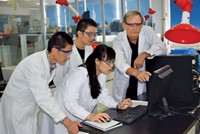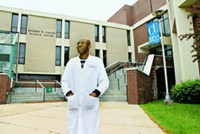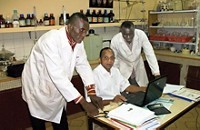Advertisement
Grab your lab coat. Let's get started
Welcome!
Welcome!
Create an account below to get 6 C&EN articles per month, receive newsletters and more - all free.
It seems this is your first time logging in online. Please enter the following information to continue.
As an ACS member you automatically get access to this site. All we need is few more details to create your reading experience.
Not you? Sign in with a different account.
Not you? Sign in with a different account.
ERROR 1
ERROR 1
ERROR 2
ERROR 2
ERROR 2
ERROR 2
ERROR 2
Password and Confirm password must match.
If you have an ACS member number, please enter it here so we can link this account to your membership. (optional)
ERROR 2
ACS values your privacy. By submitting your information, you are gaining access to C&EN and subscribing to our weekly newsletter. We use the information you provide to make your reading experience better, and we will never sell your data to third party members.
Education
Art and Science
Smithsonian Chemists Squeezed Out Of Analytical Jobs
by Rachel Petkewich
November 7, 2005
| A version of this story appeared in
Volume 83, Issue 45
At the intersection of art and science, analytical chemists have problems to solve.
John Winter is one of three permanent researchers at the Smithsonian Institutes Arthur M. Sackler and Freer Galleries in Washington, D.C. We have our separate fields of research just as any scientist does, he says. With 25 years of experience, his specialty is East Asian paintings. Winter is also in charge of examining pieces under consideration for acquisition by the galleries for things like disguised repairs and added decorations, which are far more common than out-and-out forgery.
In his work, he uses analytical chemistry techniques for identification of materials, including X-ray fluorescence and diffraction, IR, UV-Vis, GC-MS, HPLC, and scanning electron microscopy.
To be a good candidate in this field, you cant afford to be too specialized, Winter says. Originally a natural products chemist, he has forayed into botanical multivariate statistical analysis.
Charles Tumosa echoes those ideas. With a doctorate in physical chemistry, he worked on 4,000 homicides during his 18-year tenure running the crime lab for the Philadelphia Police Department before switching gears to set up the analytical laboratory at the Smithsonian Center for Materials Research & Education (SCMRE) in Suitland, Md. The mandate was to help to preserve the collection. I always joked that it was a place where we watched paint dry, he quips. But no one has ever done a linear study on how paint ages, and that is one example of what we were doing.
Tumosa enjoyed working at the Smithsonian Institution for 12 years. What we learned we learned the hard way, and that knowledge is not in books, its not on the Web.
On Sept. 16, however, he lost his job. Positions were abolished for six of the seven research scientists who worked on independent projects at SCMRE. We were probably one of the last places to do materials science in the arts, he says.
It is curious that the National Academy of Sciences thought very highly of our research when they reviewed it and wanted the work expanded rather than curtailed or eliminated, Tumosa says. Its a very unsettled time at the Smithsonian, and I think we are a little bit of the collateral damage that occurred.
Winter calls the cut an anomaly to the field as a whole. Recent infusions of money from private foundations provided for new permanent positions at museums in Baltimore, Chicago, and New York City.
Tumosa sees temporary hires as the newest trend and is looking into teaching. People at various universities and colleges who are in science departments get involved as well, either as a sideline or as their main area of research.






Join the conversation
Contact the reporter
Submit a Letter to the Editor for publication
Engage with us on Twitter